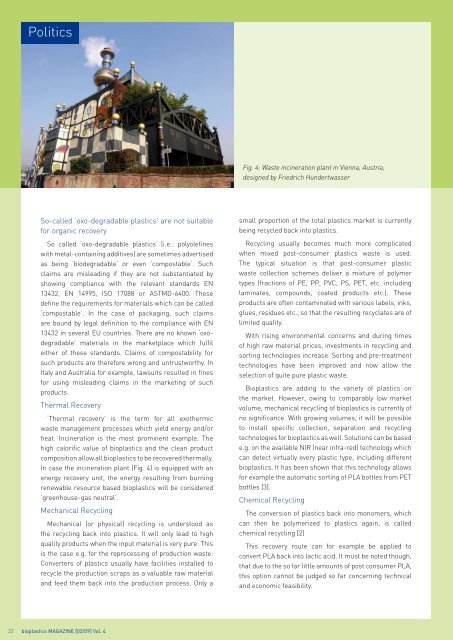bioplasticsMAGAZINE_0902
bioplasticsMAGAZINE_0902
bioplasticsMAGAZINE_0902
You also want an ePaper? Increase the reach of your titles
YUMPU automatically turns print PDFs into web optimized ePapers that Google loves.
Politics<br />
Fig. 4: Waste incineration plant in Vienna, Austria,<br />
designed by Friedrich Hundertwasser<br />
So-called ‘oxo-degradable plastics’ are not suitable<br />
for organic recovery<br />
So called ‘oxo-degradable plastics’ (i.e.: polyolefines<br />
with metal-containing additives) are sometimes advertised<br />
as being ‘biodegradable’ or even ‘compostable’. Such<br />
claims are misleading if they are not substantiated by<br />
showing compliance with the relevant standards EN<br />
13432, EN 14995, ISO 17088 or ASTMD-6400. These<br />
define the requirements for materials which can be called<br />
‘compostable’. In the case of packaging, such claims<br />
are bound by legal definition to the compliance with EN<br />
13432 in several EU countries. There are no known ‘oxodegradable’<br />
materials in the marketplace which fulfil<br />
either of these standards. Claims of compostability for<br />
such products are therefore wrong and untrustworthy. In<br />
Italy and Australia for example, lawsuits resulted in fines<br />
for using misleading claims in the marketing of such<br />
products.<br />
Thermal Recovery<br />
‘Thermal recovery’ is the term for all exothermic<br />
waste management processes which yield energy and/or<br />
heat. Incineration is the most prominent example. The<br />
high calorific value of bioplastics and the clean product<br />
composition allow all bioplastics to be recovered thermally.<br />
In case the incineration plant (Fig. 4) is equipped with an<br />
energy recovery unit, the energy resulting from burning<br />
renewable resource based bioplastics will be considered<br />
‘greenhouse-gas neutral’.<br />
Mechanical Recycling<br />
Mechanical (or physical) recycling is understood as<br />
the recycling back into plastics. It will only lead to high<br />
quality products when the input material is very pure. This<br />
is the case e.g. for the reprocessing of production waste:<br />
Converters of plastics usually have facilities installed to<br />
recycle the production scraps as a valuable raw material<br />
and feed them back into the production process. Only a<br />
small proportion of the total plastics market is currently<br />
being recycled back into plastics.<br />
Recycling usually becomes much more complicated<br />
when mixed post-consumer plastics waste is used.<br />
The typical situation is that post-consumer plastic<br />
waste collection schemes deliver a mixture of polymer<br />
types (fractions of PE, PP, PVC, PS, PET, etc. including<br />
laminates, compounds, coated products etc.). These<br />
products are often contaminated with various labels, inks,<br />
glues, residues etc., so that the resulting recyclates are of<br />
limited quality.<br />
With rising environmental concerns and during times<br />
of high raw material prices, investments in recycling and<br />
sorting technologies increase. Sorting and pre-treatment<br />
technologies have been improved and now allow the<br />
selection of quite pure plastic waste.<br />
Bioplastics are adding to the variety of plastics on<br />
the market. However, owing to comparably low market<br />
volume, mechanical recycling of bioplastics is currently of<br />
no significance. With growing volumes, it will be possible<br />
to install specific collection, separation and recycling<br />
technologies for bioplastics as well. Solutions can be based<br />
e.g. on the available NIR (near infra-red) technology which<br />
can detect virtually every plastic type, including different<br />
bioplastics. It has been shown that this technology allows<br />
for example the automatic sorting of PLA bottles from PET<br />
bottles [3].<br />
Chemical Recycling<br />
The conversion of plastics back into monomers, which<br />
can then be polymerized to plastics again, is called<br />
chemical recycling [2]<br />
This recovery route can for example be applied to<br />
convert PLA back into lactic acid. It must be noted though,<br />
that due to the so far little amounts of post consumer PLA,<br />
this option cannot be judged so far concerning technical<br />
and economic feasibility.<br />
22 bioplastics MAGAZINE [02/09] Vol. 4


















